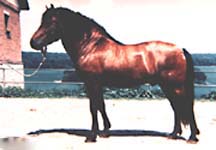Carpathian Pony
Hucul
Sun, 17th November, 2024 - 10:59 am GMT
Sponsor Ads:

Alternative Name
HuculBasic Info
The Hucul has a rectangular body shape with its length being two or three inches greater than its height at the withers (53 - 57"). The croup is well developed; the chest is deep and broad; the head is expressive with large eyes and small lively ears. The neck is strong and muscular and the back is very strong. The hooves are small and hard and usually the Hucul does not require shoes. Bay, black, grullo and chestnut are the most common colors with a dorsal stripe and zebra stripes on the legs characteristic of the breed.
Health
This small horse is very strong and resistant to illnessesHabitat
N/ABehavior
Capable of living outdoors year round, finding its own food. The legs are extremely strong without known ailments. The breed is very sure-footed and able to maintain good speed while trotting on sloping ground or over dangerous trails in the mountainsOrigin
Carpathian Mountain range of Eastern EuropeHistory
The Hucul or Carpathian pony originated in the Carpathian Mountain range of Eastern Europe. Borders have changes many times throughout history along this mountain range therefore both Romania and Poland claim to be the country of origin for this breed. The Hucul dates to the thirteenth century and is believed to have descended from the crossing of the wild Tarpan with Mongolian horses. Migratory tribes, like the Mongols, introduced the horse to this region. The natural range of this little horse covers a great distance. Their habitat is the eastern Carpathians, called Huzulland. For hundreds of years Huculs have bred in the mountains under very difficult climatic conditions. Isolated from other horses, the breed developed into a resistant and robust horse. In 1856 a stud farm for this breed was first established at Roaduti, Romania. Several bloodlines were established by the foundation stallions -- Goral, Hroby, Ousor, Pietrousu and Prislop -- and the horses were carefully bred to preserve the purity of these bloodlines. In 1922, thirty-three horses were sent to Czechoslovakia to establish a herd there which would become the Gurgul line. World War II caused a severe decline in the number of Hucul horses in Czechoslovakia. It was not until the early 1970s that concerned breeders established an organization, Hucul Club, to address the declining number of Huculs in Czechoslovakia. In 1982 they established a stud book with fifty purebred animals and the goal of increasing the numbers in that region. Today, Huculs are bred mainly in the Bucovina region of Romania as well as Hungary, regions of the Slovak Republic and areas of the former Soviet Union. In recent years the popularity of this bred has even spread as far as England.Common Foods
grassSponsor Ads:
"Indirect tactics, efficiently applied, are inexhaustible as Heaven and Earth, unending as the flow of rivers and streams; like the sun and moon, they end but to begin anew; like the four seasons, they pass away to return once more." -- Sun Tzu, The Art of War
Carpathian Pony
Coded by: BGID® | ALL RIGHTS RESERVED Copyright © 2000-2024
Disclaimer | Privacy | Report Errors / Contact | Credits


 Beware the new Naval power, they are planning to come on stream with big naval might to match their ground forces. Chinese Aircraft Carrier - Chinese Navy
Beware the new Naval power, they are planning to come on stream with big naval might to match their ground forces. Chinese Aircraft Carrier - Chinese Navy  versus
versus 
 versus
versus  This Thread is about the North Korean Military itself - the kind of army, navy, and air force they have.
This Thread is about the North Korean Military itself - the kind of army, navy, and air force they have. 
 versus
versus  versus
versus 
 versus
versus  versus
versus